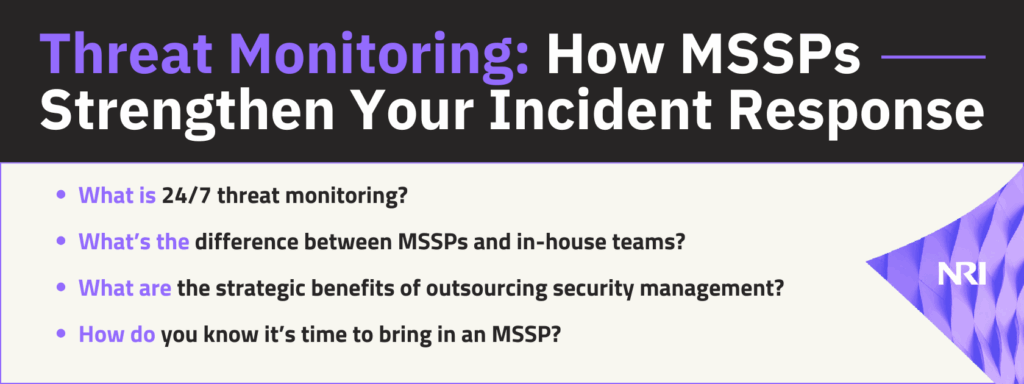Discover how round-the-clock monitoring works and its ROI in minimizing breaches.

Are you investing strategically to optimize your cybersecurity?
Today’s constant threats demand constant vigilance.
Q1 2025 saw a 47% year-over-year surge in attacks, with the government, education, healthcare, automotive, manufacturing, and finance sectors among the most targeted, according to Check Point.
Further, evolving tactics and short breach windows now characterize the threat landscape. In the 2025 Global Threat Report, Crowdstrike warns of more focused, efficient, and “enterprising” adversaries that organizations shouldn’t underestimate.
Readily accessible artificial intelligence (AI) tools and other advanced technologies, for example, allow today’s “enterprising adversaries” to move laterally across networks in just 48 minutes on average.
Delayed detection can be costly. For example, IBM’s recent report reveals that breaches undetected beyond 200 days cost an average of $5.46 million on average, while those detected within 200 days cost an average of $4.07 million. And it typically takes organizations about 258 days to identify and contain a breach.
With AI-powered threat monitoring and incident response capabilities, organizations accelerate the mean time to identify (MTTI) and mean time to contain (MTTC) by 43% for prevention and 33% for response. Additionally, they save up to $2.21 million.
Read on to discover how managed security services providers (MSSPs) are third-party experts that monitor and manage security systems. They deliver round-the-clock threat visibility to minimize breaches and maximize the value of cybersecurity investments.
What 24/7 Threat Monitoring Really Means
In 24/7 threat monitoring, a dedicated security operations center (SOC) operates around the clock to collect and analyze massive telemetry streams (logs, network flows, endpoint data, etc.), correlate events, flag potential threats, and contain them in real time.
The emphasis is on proactively searching for signs of compromise, catching incidents early, and reducing their impact rather than waiting for or reacting to alerts.
- Security Information and Event Management (SIEM) tools aggregate and correlate events from your firewalls, endpoints, cloud environments, and Operational Technology (OT) systems to identify suspicious activity.
- Security Orchestration, Automation, and Response (SOAR) tools automate containment, enabling faster and more coordinated responses. For example, if ransomware is detected, the affected device is isolated, credentials are disabled, and forensic imaging is initiated within seconds.
- Threat Intelligence tools integrate external threat feeds, such as malware indicators, attack signatures, and vulnerability disclosures. Whenever a new threat emerges, it’s immediately added to your detection rules, ensuring rapid adaptation.
- Anomaly Detection tools leverage AI and machine learning (ML) to baseline normal user and system behavior, flag those indicative of an attack (e.g., atypical login times, mass downloads to an unfamiliar IP address), and trigger an automated investigation.
In essence, 24/7 threat monitoring means having a living, breathing security program that is always active.
MSSPs vs. In-House Teams: A Strategic Partnership
Building, maintaining, and scaling an internal, around-the-clock security operation can be a challenging task. Security Magazine estimates that the average Security Operations Center (SOC) requires at least five security analysts. In today’s landscape, hiring security professionals is neither easy nor inexpensive. Additionally, there are the costs of technology licenses, hardware, and training programs for analysts. Add these, and the total annual costs of an in-house SOC in a large enterprise can reach $2.86 million.
Forward-thinking organizations increasingly partner with an MSSP, delegating security operations fully or partially to enhance their overall capabilities cost-effectively. MSSPs allow you to access a diverse team of experienced security professionals with up-to-date domain expertise. That means you don’t have to worry about the cost of hiring, rehiring, or training staff. Additionally, because MSSPs serve many clients, they can spread the cost of enterprise SIEM, SOAR, and threat intelligence tools across multiple clients. This translates to a lower per-unit cost for your organization.
Real-World ROI: Faster Detection, Lower Impact
Two essential factors when evaluating cybersecurity return on investment (ROI) are how fast a solution allows you to detect and respond to threats. According to IBM’s 2024 Data Breach Report, the global average MTTI and MTTR are 194 and 64 days, respectively.
When analyzing what factors tend to lower these metrics, IBM found one constant: AI. Extensive use of security AI across prevention, detection, investigation, and response reduces MTTI and MTTR by 100 days.
The same applies to reducing the average cost of a breach, including downtime, regulatory fines, and mitigation, which now stands at $4.88 million. Leveraging AI and ML-driven insights results in a $258,538 reduction in costs.
Other factors that reduce the financial impact of a breach include:
- Security team with up-to-date expertise ($258,629)
- SIEM ($255,932)
- SOAR (214,603)
- Threat intelligence (243,090)
- Proactive threat hunting ($219,074)
- MSSP partnership ( $92,734)
Put differently, the right expertise and tools are crucial to optimizing your cybersecurity strategy.
When It’s Time to Bring in a Trusted MSSP
How do you know if it’s time to tap an MSSP? Here are some telltale signs:
- Your business has expanded (or plans to expand), whether through a merger and acquisition (M&A) or by serving new regions or customer segments.
- New or updated compliance requirements mandate more rigorous monitoring and incident reporting.
- Cloud adoption, remote work, and IoT devices have expanded your exposure.
- Your bench lacks enough depth to cover all security bases, or you want to shift focus to strategic business objectives.
Three factors to keep top of mind when evaluating MSSPs are transparency, threat intelligence, and response capability.
- Do they keep detailed incident reports?
- What are some examples of threats they helped detect and thwart?
- What’s the average MTTI/MTTR across the clients they serve?
- Do they integrate high-quality global and sector-specific threat feeds?
- What is their incident response playbook?
- Can they tailor security solutions to your unique business needs and risks?
When the world’s most preeminent enterprises want leading-edge security solutions to combat modern threats, they turn to NRI. We deliver around-the-clock protection and actionable threat response backed by proven expertise, advanced SOC capabilities, and industry-specific insight.
Want to learn more? Schedule a custom consultation to discover why NRI is the right security partner for your organization.



